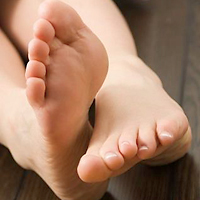

A collapsed arch from RA can make walking difficult. Find out how to protect your feet from the effects of joint destruction.

Perhaps you haven’t thought much about the relationship between rheumatoid arthritis and feet, but rheumatoid arthritis can attack any joint in your body — and that includes any of the 29 joints in your feet and ankles. An attack on your foot can tighten tendons and connective tissue, putting you at risk for joint destruction, deformity, and a collapsed arch. Nine of 10 people with rheumatoid arthritis will feel its effects in their feet at some point. But the good news, experts say, is that modern medications are cutting down on the number of people with severely flat feet.
Flat feet are no laughing matter. They affect the way you walk, increase pain, and trigger a domino effect that puts stress on joints all the way up your legs to your hips and back as you try to stay mobile and compensate by throwing off your gait.
Although rheumatoid arthritis (RA) medications can effectively slow disease progression and protect your feet, the risk for collapsed arches remains. Over time you might notice changes in the way your feet feel and function. Signs include pain and swelling in your feet, difficulty walking without pain (and changes in gait in order to compensate for the pain), and deformities such as bunions and hammertoes. How far your RA has progressed in your feet directly relates to your options for treatment.
At first you might experience pain and tightness from inflamed tendons and connective tissues. “Sometimes rheumatoid patients will get an inflammation of the sheath of the tendon,” explained orthopedist Jamal Ahmad, MD, an assistant professor of orthopedics with Thomas Jefferson University Hospitals in Philadelphia. This increases pain in your foot, alters the way you walk, and prevents your foot from working well.
Eventually, RA can progress to the point where your joints become deformed and do not work well. Your arch has strength and flexibility thanks to three small joints underneath your ankle. As rheumatoid arthritis degrades these joints, the arch begins to fall.
X-rays can help your doctor determine how far RA has progressed in your foot. “On X-rays, if someone has arthritis that’s causing the flat foot, you’ll see that the joint space is degenerated or narrowed,” said Dr. Ahmad. If you have foot pain and deformity but the imaging tests do not show any changes in the spacing of your joints, chances are you’re suffering more from tightened tendons and ligaments. This is an important distinction because the treatment options depend on whether tendons or joints are the cause of your trouble.
“As the ligaments fail, the flat foot gets worse and worse,” explained orthopedic surgeon Daniel Farber, MD, an assistant professor of orthopedics at the University of Maryland School of Medicine and a spokesman for the American Academy of Orthopaedic Surgeons.
In addition to the RA medications you take to control the disease and inflammation, treatment for inflamed tendons could include:
Dr. Farber emphasized that starting with nonsurgical options early in the course of developing flat feet is less expensive and can be effective.
If you're hoping to avoid flat feet and want to be proactive, Farber pointed out that you can help protect your feet by wearing good supportive shoes with arch support and maintaining flexibility in the tendons. "We know that the tight tendon will make the flat foot worse, forcing the foot up and out.” Stretching and exercise can help keep tendons flexible. Farber also emphasizes the importance of working with a rheumatologist to protect all your joints, including those in your feet.
Ahmad explained that you’re more likely to need surgery once your joints are affected. Even at this point, however, you will have several options depending on whether you still have any flexibility in your foot.
“When I look at flat feet, there’s a difference between flexible and rigid,” Ahmad noted, explaining that the goal of treatment is to reduce pain, improve movement, and repair deformities.
If you still have some flexibility, your orthopedist might re-create an arch by manipulating parts of your foot, either with inserts or with braces to reshape it.
An insert can't correct a foot that has fallen flat and is rigid though. "Once those joints become arthritic, you can’t move them,” Ahmad explained. Rigidity is a sign that other options, such as fusion of the troubled joints, need to be considered.
For instance, fusing three of the joints can give you back your arch. The arch will be rigid, said Ahmad, but if you're considering fusion because you've lost a lot of mobility in your feet and, quite likely, your ankles, that might be an acceptable trade-off for less pain and less deformity. Your foot won't splay out and you can wear normal shoes, he said.
Keep in mind that you'll need time to heal. Your long-standing RA medications can make wound and bone healing more difficult, Ahmad pointed out.
Also, having realistic expectations is crucial, he said. You won’t be as flexible as you once were, but you should be able to walk with less pain and awkwardness after surgery.
Copyright © www.orthopaedics.win Bone Health All Rights Reserved